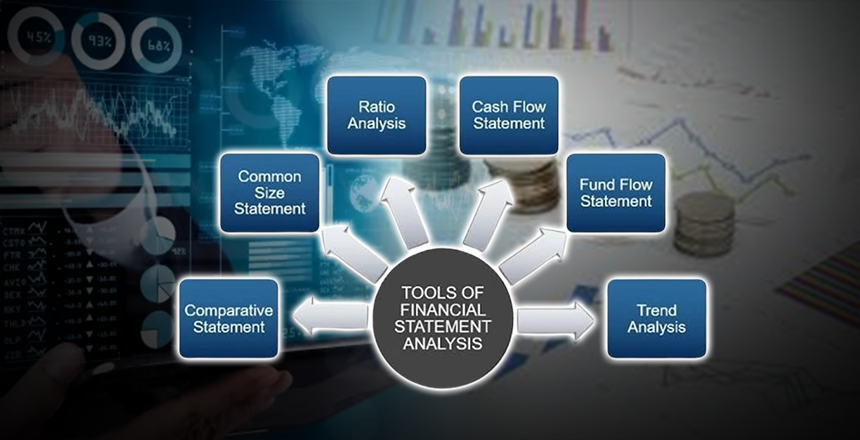Tools of Financial Statement Analysis

Monetary investigation of the assertion is an essential method for organizations, financial backers, and other monetary faculty to assess the monetary strength and activity of an association. Thus, through analyzing the financial statements, it will be possible for the stakeholders to make the right decisions in investments, loans, and management, among other areas. This blog focuses on the instruments applied in financial statement analysis and gives a clear explanation of each instrument as a tool in determining the financial position of a firm.
What does it mean to analyze financial statements?
A technique for assessing and translating an organization's pay proclamation, monetary record, and income explanation to discover its monetary wellbeing and productivity.
Tools of Financial Statement Analysis blog post contains some important points about the key tools as follows:
Some of the analysis tools and methods that can be used on financial statements include the following: They assist in making some sense out of the numbers provided in the financial statements and come up with conclusions. Here are the most commonly used tools:Here are the most commonly used tools:
1. Horizontal Analysis
This tool assists in explaining how items on financial statements—revenue or expenses, for instance—have evolved over time.
Purpose: To make predictions and forecast the general direction of growth in the collected financial data.
How It Works: In this way, comparing the figures in different periods, analysts define whether the companies’ performance increases or decreases, or remains at the same level.
2. Vertical Analysis
Vertical analysis entails the use of percentages to analyze and compare the different items in the financial statements. For instance, in an income statement, every expense could be described as having a certain proportion of the overall sales.
Purpose: In order to compare the size of items that are contained in the financial statements.
How It Works: In a balance sheet, every figure is stated as a proportion of total assets—be it an asset or liability or shareholders’ equity. In an income statement, costs and expenses arecategorized in terms of the percentage of the net sales.
3. Ratio Analysis
Proportion investigation is one of the most seasoned and most broadly involved procedures for budget report examination. It encompasses calculating numerous ratios from financial data with the aim of evaluating efficiency, profitability, liquidity, and solvency of the firm.
Aim: To summarize its financial position and show its performance for the fiscal year at the conclusion of the fiscal period.
Key Ratios:
Liquidity ratios: Assess its level of liquidity to reflect how well it is placed to fulfill short-term commitments. Example: Current ratio, quick ratio.
Profitability ratios: Evaluate its profitability performance in terms of profit margin sales, assets, or equity. Example: such profit indicators as gross margin, operating margin, net profit margin, and return on equity (ROE).
Solvency ratios: Assess the firm’s capability in managing long-term liabilities. Obligation Value Proportion or Absolute Obligation Value Proportion, Interest Inclusion Proportion.
Efficiency ratios: Assess the firm’s capability in managing long-term liabilities. Obligation Value Proportion or Absolute Obligation Value Proportion, Interest Inclusion Proportion.
4. DuPont Analysis
The analysis of DuPont is a sophisticated ratio analysis that disintegrates return on equity (ROE) into three sections: sales of the firm, operating income, net profit margin, fixed asset turnover, and financial leverage. This breakdown goes further to explain the factors that may cause or contribute to a certain company’s return on equity.
Purpose: As to identify and suggest changes to different drivers of the company’s return on equity.
How It Works:
Net profit margin: They do measure profitability because it is a measure of how much the business company has been able to make out of the financial resources that investors have put in the business.
Equity multiplier: Indicates the level of financial risk associated with operations.
5. Cash Flow Analysis
The generation and utilization of cash in a business can be identified through a cash flow statement hence cash flow analysis emphasizes on this particular aspect. Financial flexibility is a significant aspect that gives a better picture of the liquidity of a company.
Purpose: To assess the flow of cash in and out of the business to identify its capability of generating cash and paying its bills.
Key Areas:
Investing Activities: The amount of cash generated from the sale of assets and also the amount of cash spent both in acquiring new assets as well as in disposing off the existing ones.
Financing Activities: Actualization of funds needed to achieve goals from internal and external sources; repayment of borrowed capital; funds invested in securities; amount of money paid out in dividends.
6. Common-size Financial Statements
Common-size financial statements are merely one sort of vertical analysis where each statistical number is expressed as a percentage ratio of a base figure in the financial statements. It can also be used for comparison with other firms of either different scale or at different periods of time, though the fault is in the same company.
Purpose: To bring balance to such accounts in order to make comparison possible.
Key Areas:
How It Works: The revenue report has all components represented as a part of the revenue. In a balance sheet format, each and every balance is presented as a percentage of the total asset.
Financing Activities: Actualization of funds needed to achieve goals from internal and external sources; repayment of borrowed capital; funds invested in securities; amount of money paid out in dividends.
7. Break-Even Analysis
Contribution analysis identifies how much revenue is needed by comparing total fixed and variable costs in an attempt to make neither profit nor loss. It is an effective means of analyzing the correlation between cost, the amount of work volume, and the profit received.
Purpose: To find out the amount of sales that is necessary to get a positive net income, or at least not a negative one.
Key Areas:
How It Works: The break-even point helps a company decide its sales strategy and the pricing policy that it intends to adopt.
8. Comparative Financial Statements
The comparative financial statements align the financial statements of different periods, which in return help in the comparison of the financial outcome of the different periods. This tool is normally used together with horizontal analysis.
Purpose: To offer a means by which financial statements can be compared so that one period can be compared with another.
How It Works: Revenue and expense reports from various periods are shown in a tabular form to show changes in various relevant measures.
9. Economic Value Added (EVA)
Economic value added (EVA), on the other hand, is an economic profit and loss metric that measures how much a company has generated economic profit over and above the cost of capital of the shareholders. It is arrived at by deducting the cost of capital from net operating profit after taxes (NOPAT).
Purpose: The purpose of stock valuation is to measure to what extent a company is making shareholder value.The purpose of stock valuation is to measure to what extent a company is making shareholder value.
How It Works: EVA, or economic value added, is an indicator that shows that the company can attain returns in excess of its cost of capital, or a figure below it if it is negative.
Conclusion
Analyzing the financial statements is one of the most effective techniques for deciphering the financial health of a business entity and making decisions. Horizontal and vertical analysis, ratio analysis, DuPont analysis, cash flow analysis, and others are advanced tools, and through the use of these tools, the analyst is able to gain a better understanding of a company.
These tools, if applied correctly, assist businesses and investors in evaluating their strengths, weaknesses, opportunities, and threats in the financial environment. As an experienced investor, a financial analyst, an entrepreneur, or any person interested in managing his or her financial resources effectively, there is a need to develop knowledge about those tools.
- Written By - Natasha Singh









